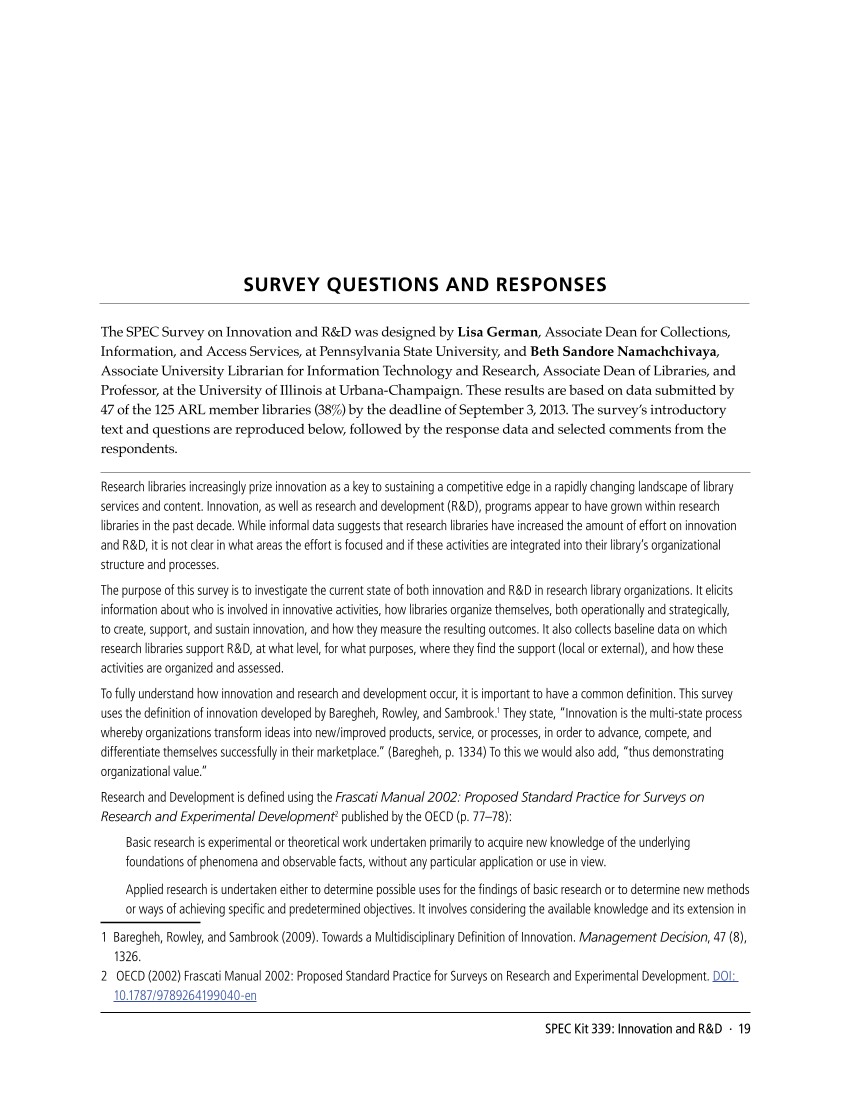SPEC Kit 339: Innovation and R&D · 19
SURVEY QUESTIONS AND RESPONSES
The SPEC Survey on Innovation and R&D was designed by Lisa German, Associate Dean for Collections,
Information, and Access Services, at Pennsylvania State University, and Beth Sandore Namachchivaya,
Associate University Librarian for Information Technology and Research, Associate Dean of Libraries, and
Professor, at the University of Illinois at Urbana-Champaign. These results are based on data submitted by
47 of the 125 ARL member libraries (38%) by the deadline of September 3, 2013. The survey’s introductory
text and questions are reproduced below, followed by the response data and selected comments from the
respondents.
Research libraries increasingly prize innovation as a key to sustaining a competitive edge in a rapidly changing landscape of library
services and content. Innovation, as well as research and development (R&D), programs appear to have grown within research
libraries in the past decade. While informal data suggests that research libraries have increased the amount of effort on innovation
and R&D, it is not clear in what areas the effort is focused and if these activities are integrated into their library’s organizational
structure and processes.
The purpose of this survey is to investigate the current state of both innovation and R&D in research library organizations. It elicits
information about who is involved in innovative activities, how libraries organize themselves, both operationally and strategically,
to create, support, and sustain innovation, and how they measure the resulting outcomes. It also collects baseline data on which
research libraries support R&D, at what level, for what purposes, where they find the support (local or external), and how these
activities are organized and assessed.
To fully understand how innovation and research and development occur, it is important to have a common definition. This survey
uses the definition of innovation developed by Baregheh, Rowley, and Sambrook.1 They state, “Innovation is the multi-state process
whereby organizations transform ideas into new/improved products, service, or processes, in order to advance, compete, and
differentiate themselves successfully in their marketplace.” (Baregheh, p. 1334) To this we would also add, “thus demonstrating
organizational value.”
Research and Development is defined using the Frascati Manual 2002: Proposed Standard Practice for Surveys on
Research and Experimental Development2 published by the OECD (p. 77–78):
Basic research is experimental or theoretical work undertaken primarily to acquire new knowledge of the underlying
foundations of phenomena and observable facts, without any particular application or use in view.
Applied research is undertaken either to determine possible uses for the findings of basic research or to determine new methods
or ways of achieving specific and predetermined objectives. It involves considering the available knowledge and its extension in
1 Baregheh, Rowley, and Sambrook (2009). Towards a Multidisciplinary Definition of Innovation. Management Decision, 47 (8),
1326.
2 OECD (2002) Frascati Manual 2002: Proposed Standard Practice for Surveys on Research and Experimental Development. DOI:
10.1787/9789264199040-en
SURVEY QUESTIONS AND RESPONSES
The SPEC Survey on Innovation and R&D was designed by Lisa German, Associate Dean for Collections,
Information, and Access Services, at Pennsylvania State University, and Beth Sandore Namachchivaya,
Associate University Librarian for Information Technology and Research, Associate Dean of Libraries, and
Professor, at the University of Illinois at Urbana-Champaign. These results are based on data submitted by
47 of the 125 ARL member libraries (38%) by the deadline of September 3, 2013. The survey’s introductory
text and questions are reproduced below, followed by the response data and selected comments from the
respondents.
Research libraries increasingly prize innovation as a key to sustaining a competitive edge in a rapidly changing landscape of library
services and content. Innovation, as well as research and development (R&D), programs appear to have grown within research
libraries in the past decade. While informal data suggests that research libraries have increased the amount of effort on innovation
and R&D, it is not clear in what areas the effort is focused and if these activities are integrated into their library’s organizational
structure and processes.
The purpose of this survey is to investigate the current state of both innovation and R&D in research library organizations. It elicits
information about who is involved in innovative activities, how libraries organize themselves, both operationally and strategically,
to create, support, and sustain innovation, and how they measure the resulting outcomes. It also collects baseline data on which
research libraries support R&D, at what level, for what purposes, where they find the support (local or external), and how these
activities are organized and assessed.
To fully understand how innovation and research and development occur, it is important to have a common definition. This survey
uses the definition of innovation developed by Baregheh, Rowley, and Sambrook.1 They state, “Innovation is the multi-state process
whereby organizations transform ideas into new/improved products, service, or processes, in order to advance, compete, and
differentiate themselves successfully in their marketplace.” (Baregheh, p. 1334) To this we would also add, “thus demonstrating
organizational value.”
Research and Development is defined using the Frascati Manual 2002: Proposed Standard Practice for Surveys on
Research and Experimental Development2 published by the OECD (p. 77–78):
Basic research is experimental or theoretical work undertaken primarily to acquire new knowledge of the underlying
foundations of phenomena and observable facts, without any particular application or use in view.
Applied research is undertaken either to determine possible uses for the findings of basic research or to determine new methods
or ways of achieving specific and predetermined objectives. It involves considering the available knowledge and its extension in
1 Baregheh, Rowley, and Sambrook (2009). Towards a Multidisciplinary Definition of Innovation. Management Decision, 47 (8),
1326.
2 OECD (2002) Frascati Manual 2002: Proposed Standard Practice for Surveys on Research and Experimental Development. DOI:
10.1787/9789264199040-en
































































































































































































